Valencia, California
Some people may find what I am about to say disturbing. Children and those with weak constitutions should leave the webpage immediately. Roller Coaster Philosophy bears no responsibility for any psychological damage the following piece of information may cause. Be absolutely certain you understand the risks involved before you read the next line. Last chance. Are you ready? Brace yourself.
Déjà Vu was closed the entire weekend.
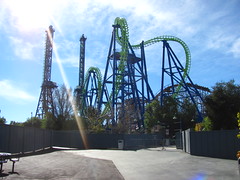 Shocking, I know. A ride built a decade ago still can’t operate like a normal coaster. Granted, it may have been for a normally scheduled off-season rehab, but Six Flags posts no rehab schedules so it’s hard to be certain. Experiencing Déjà Vu has become a notoriously rare and privileging event, like witnessing a total eclipse. I can count three Giant Inverted Boomerang encounters in my lifetime (out of a total of six visits to parks with a GIB on property), two of which were on the same day back in 2002 on this very model, an unknown motivation possessing us to wait in another three-hour queue well after midnight after we had already done it once that morning. I guess it was because they are indeed quite fun rides, with the extended weightlessness on both of the vertical towers mixed between the rapid-fire giant inversions,
Shocking, I know. A ride built a decade ago still can’t operate like a normal coaster. Granted, it may have been for a normally scheduled off-season rehab, but Six Flags posts no rehab schedules so it’s hard to be certain. Experiencing Déjà Vu has become a notoriously rare and privileging event, like witnessing a total eclipse. I can count three Giant Inverted Boomerang encounters in my lifetime (out of a total of six visits to parks with a GIB on property), two of which were on the same day back in 2002 on this very model, an unknown motivation possessing us to wait in another three-hour queue well after midnight after we had already done it once that morning. I guess it was because they are indeed quite fun rides, with the extended weightlessness on both of the vertical towers mixed between the rapid-fire giant inversions,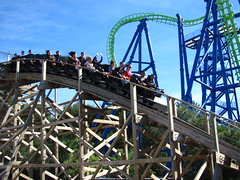 a delectable club sandwich of tower-loops-tower-loops-tower (though that last ‘tower’ is a bit soft and soggy). From 2002 I mostly remember standing in a cattle corral while the ride repeatedly broke down, the rest of the park long-since emptied, waiting behind three guys who could evidently speak seven different languages to impress the ladies. Happy memories. While Vekoma got a B+ in the design of a fun compact layout, they got a D- for their market research. The rides are too big and complicated for a small park to purchase new off the lot, but too low capacity to meet the daily demand needs for any large regional park like Six Flags… and apparently too prone to downtime for any potential buyer to consider keeping in the long run, deep-pocketed or not.
a delectable club sandwich of tower-loops-tower-loops-tower (though that last ‘tower’ is a bit soft and soggy). From 2002 I mostly remember standing in a cattle corral while the ride repeatedly broke down, the rest of the park long-since emptied, waiting behind three guys who could evidently speak seven different languages to impress the ladies. Happy memories. While Vekoma got a B+ in the design of a fun compact layout, they got a D- for their market research. The rides are too big and complicated for a small park to purchase new off the lot, but too low capacity to meet the daily demand needs for any large regional park like Six Flags… and apparently too prone to downtime for any potential buyer to consider keeping in the long run, deep-pocketed or not.
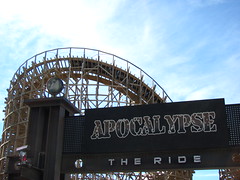 In all honesty I could hardly be bothered by this closure when there was a far better attraction worthy of my time mere paces away. Originally opening as Terminator Salvation: The Ride, the rechristened Apocalypse has been hailed by many as one of the best roller coaster Great Coasters Intl. has built to date. Then again, it seems every ride GCI constructs has people declaring on internet message boards that they have found GCI’s best-ever, so I generally hold off on ranking their coasters until I’ve ridden myself, as it looks a tad unprofessional place every contender as #1. And to be honest, I was always more skeptical towards Apocalypse than I was toward Great Coaster’s other recent layouts. Not that I doubted it would be a very good ride, indeed I figured it would be one of the park’s attractions worth devoting the largest share
In all honesty I could hardly be bothered by this closure when there was a far better attraction worthy of my time mere paces away. Originally opening as Terminator Salvation: The Ride, the rechristened Apocalypse has been hailed by many as one of the best roller coaster Great Coasters Intl. has built to date. Then again, it seems every ride GCI constructs has people declaring on internet message boards that they have found GCI’s best-ever, so I generally hold off on ranking their coasters until I’ve ridden myself, as it looks a tad unprofessional place every contender as #1. And to be honest, I was always more skeptical towards Apocalypse than I was toward Great Coaster’s other recent layouts. Not that I doubted it would be a very good ride, indeed I figured it would be one of the park’s attractions worth devoting the largest share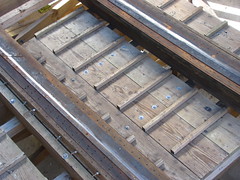 of my time on before I ever arrived in Los Angeles. But the combination of it being pretty short by wooden coaster standards and having a kind of ugly appearance sent up a few red flags. Apocalypse’s 2877 feet is about a garden hose longer than the Raven, a layout notorious for proving bigger isn’t always better and has had more than one newbie enthusiast return to the station asking “is that all there is?” And I really don’t care for the aesthetics of the coaster from the midway. The layout is constricted to fill an oddly shaped lot resulting in almost no discernable pattern or organization, and visually it’s all inward-facing fan turns against the midway shutting spectators off from the action, a far cry from the formal eloquence of the Hersheypark Wildcat’s open, swooping curves. It seems the better GCI gets at designing an on-board ride experience
of my time on before I ever arrived in Los Angeles. But the combination of it being pretty short by wooden coaster standards and having a kind of ugly appearance sent up a few red flags. Apocalypse’s 2877 feet is about a garden hose longer than the Raven, a layout notorious for proving bigger isn’t always better and has had more than one newbie enthusiast return to the station asking “is that all there is?” And I really don’t care for the aesthetics of the coaster from the midway. The layout is constricted to fill an oddly shaped lot resulting in almost no discernable pattern or organization, and visually it’s all inward-facing fan turns against the midway shutting spectators off from the action, a far cry from the formal eloquence of the Hersheypark Wildcat’s open, swooping curves. It seems the better GCI gets at designing an on-board ride experience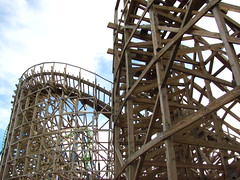 the worse they are at the off-ride experience, so hopefully this observation from the entrance will ultimately work to the ride’s advantage.
the worse they are at the off-ride experience, so hopefully this observation from the entrance will ultimately work to the ride’s advantage.
Not helping was the fact that a coaster not even two years old had already been significantly altered from its intended vision. Apocalypse is the perfect example of why I hate franchise tie-ins and special effects to sell a new ride, because you know the park is going to be a tightwad a few years down the road, refusing to renew their license for an old, second-rate blockbuster, nor maintain their effects. You’re left with a new ride that feels like a has-been before it had a full chance to-be. Even if they’ve adjusted the theme from the Former State Governor to a generic End of the World storyline, every enthusiast and local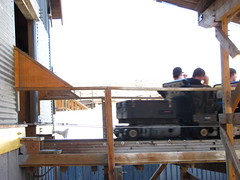 will continue to swap stories about “this used to be the Terminator coaster” for the foreseeable future, and we’ve got a flame thrower that never sparks and heavy audio components in each car with metal plates bolted over. Though I suppose the worse that can be said about all of this is it annoys the particularly obsessive enthusiasts and curbs the capacity slightly with the disused audio-box still taking the place of the twelfth car. I’ll stop being one of those obsessive enthusiassses now (at least as much as I can not be)
will continue to swap stories about “this used to be the Terminator coaster” for the foreseeable future, and we’ve got a flame thrower that never sparks and heavy audio components in each car with metal plates bolted over. Though I suppose the worse that can be said about all of this is it annoys the particularly obsessive enthusiasts and curbs the capacity slightly with the disused audio-box still taking the place of the twelfth car. I’ll stop being one of those obsessive enthusiassses now (at least as much as I can not be)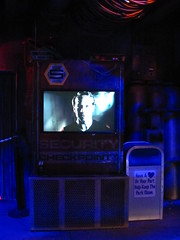 and focus on other insignificant details.
and focus on other insignificant details.
The preshow consists of a series of three themed rooms, although there’s only one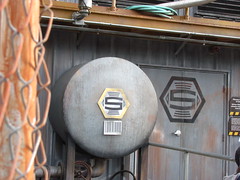 effect shared between the three of these rooms and they all involve watching television monitors explain the back-story to us. There’s never an explained cause of the apocalypse, although I could conjecture that the obliterated environment was a result of low-rent Los Angeles actors having recently chewed through all the scenery. First we’re introduced to the Good Guys (you can tell because they act very Solemn And Important) and then in the next room
effect shared between the three of these rooms and they all involve watching television monitors explain the back-story to us. There’s never an explained cause of the apocalypse, although I could conjecture that the obliterated environment was a result of low-rent Los Angeles actors having recently chewed through all the scenery. First we’re introduced to the Good Guys (you can tell because they act very Solemn And Important) and then in the next room to the Bad Guys (you can tell because they act like they’re actually having some fun, admittedly a foreign and dangerous concept to Six Flags), and then in the third room they kick each other’s asses for a bit… and while this battle for civilization is being fought, me and a couple of other wiseacres are nonchalantly trying to adjust our positions nearer to the exit door so we can get the good seats first. Preshows can be a good idea on crowded days because they essentially absorb part of what would otherwise be part of the queue, but on days like today it just meant a lot more seats were sent out empty while we were stuck waiting behind closed doors.
to the Bad Guys (you can tell because they act like they’re actually having some fun, admittedly a foreign and dangerous concept to Six Flags), and then in the third room they kick each other’s asses for a bit… and while this battle for civilization is being fought, me and a couple of other wiseacres are nonchalantly trying to adjust our positions nearer to the exit door so we can get the good seats first. Preshows can be a good idea on crowded days because they essentially absorb part of what would otherwise be part of the queue, but on days like today it just meant a lot more seats were sent out empty while we were stuck waiting behind closed doors.
This actually worked to my advantage, as on the first afternoon I was able to get six rides in a row without getting off (including twice in the front seat!), because every time we returned to the station I found that all the airgates were empty as people were still stuck waiting for the last preshow to finish. The station flythough is sort of wasted on this coaster because everyone loads directly onto the train after finishing the showrooms, and it’s partly blocked from view anyway so the room just gets a bit loud for a second while I’m buckling the seatbelts, and I pause to wonder where that sound came from as it surely wasn’t from the on-board audio anymore. The ride ops – who clearly do not take the preshow videos as seriously as the actors do – bid us brave settlers farewell as our 11-seater Millennium Flyer train rolls into the
(including twice in the front seat!), because every time we returned to the station I found that all the airgates were empty as people were still stuck waiting for the last preshow to finish. The station flythough is sort of wasted on this coaster because everyone loads directly onto the train after finishing the showrooms, and it’s partly blocked from view anyway so the room just gets a bit loud for a second while I’m buckling the seatbelts, and I pause to wonder where that sound came from as it surely wasn’t from the on-board audio anymore. The ride ops – who clearly do not take the preshow videos as seriously as the actors do – bid us brave settlers farewell as our 11-seater Millennium Flyer train rolls into the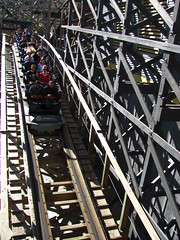 prelift dips and hops before ascending the 95’ climb.
prelift dips and hops before ascending the 95’ climb.
The Rye Aeroplane Coaster beginnings (which, like Kentucky Rumbler, doesn’t quite get the Aeroplane right due to GCI softening their curves and transitions too much) drops riders into a veritable tunnel of supports and headchoppers buried under the lift hill dramatically increasing the sense of speed, tossing us right into a high speed ejector bunny hop before rising into a large fan turn with a double dip exit. Six Flags even manages to bring something to the table with the inclusion of a tunnel on the second fan turn buried under the lift, the reverberating noise and sudden change in light levels keeping minds alert while the body granted a reprieve from the constant changing dynamics. This is followed by another fast s-curve to set up the station fly-through,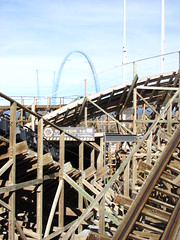 which feels like a tunnel. Retinas are flooded with daylight again for only a split second before diving into a third tunnel, the strobe between dark, light and dark bearing favorable comparisons to Tremors or Voyage.
which feels like a tunnel. Retinas are flooded with daylight again for only a split second before diving into a third tunnel, the strobe between dark, light and dark bearing favorable comparisons to Tremors or Voyage.
This sequence, which comprises about two thirds of the overall layout, is all golden GCI, especially the sequence from the first drop to the double dip. I’ve heard a few people claim they dislike GCI as they feel over-engineered and don’t get many laterals, which I suppose is true but I don’t mind it too much as they replace laterals with high rotation contrasts, and they know how to set a coaster to a beat. Even when the sequence is pretty much random, their rides always feel organic and natural as wood coasters to me (opposed to some of the Gravity Group’s faux aggressiveness mixed with B&M style parabolas and banking techniques) and nothing strikes as being out of place or of missed potential, pretty much a consequence of their improvisatory nature.
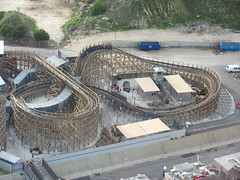 As soon as Apocalypse emerges from the second tunnel, it morphs into a very different ride than from the first two thirds, in my opinion to the detriment of the overall experience. There’s suddenly a long, high-speed right turnaround that abandons the direction changes of the first half and therefore halts the beat, which could have been an effective middle bridge if there was anything of interest on the other side. Unfortunately there is only one more direction change, this time an elevated flat left turn that doesn’t even have the advantage of good pacing. Then it’s the final brakes. This last one-third constitutes the weakest and most strikingly out-of-character finale I’ve ever come across in a GCI layout, undoubtedly a product of being ordered to fill the entirety of a lot while needing to build around queue switchbacks and preshow rooms
As soon as Apocalypse emerges from the second tunnel, it morphs into a very different ride than from the first two thirds, in my opinion to the detriment of the overall experience. There’s suddenly a long, high-speed right turnaround that abandons the direction changes of the first half and therefore halts the beat, which could have been an effective middle bridge if there was anything of interest on the other side. Unfortunately there is only one more direction change, this time an elevated flat left turn that doesn’t even have the advantage of good pacing. Then it’s the final brakes. This last one-third constitutes the weakest and most strikingly out-of-character finale I’ve ever come across in a GCI layout, undoubtedly a product of being ordered to fill the entirety of a lot while needing to build around queue switchbacks and preshow rooms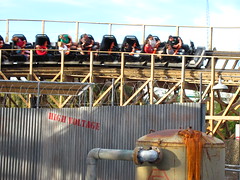 rather than as part of any deliberate creative design. That’s the disadvantage of a light-footed, improvised
rather than as part of any deliberate creative design. That’s the disadvantage of a light-footed, improvised approach to layout configuration: sooner or later the last ad-lib might become boxed into a corner, inventing a set-up with no punch-line. The slow elevated helix finale on Tatsu is resolution, on Apocalypse it is dissolution. Though perhaps the disappointing conclusion was just cleverly upholding the spirit of the original blockbuster theme.
approach to layout configuration: sooner or later the last ad-lib might become boxed into a corner, inventing a set-up with no punch-line. The slow elevated helix finale on Tatsu is resolution, on Apocalypse it is dissolution. Though perhaps the disappointing conclusion was just cleverly upholding the spirit of the original blockbuster theme.
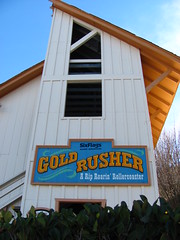 Around the next corner is Magic Mountain’s original roller coaster, recently completing 40 years of service, the Gold Rusher. You could certainly do worse as far as early-era Arrow Dynamic mine trains, this one markedly benefitting from the abundance of uneven topography. The entire layout up to the second lift hill follows perfectly the contours of the land, with nearly all of the crossties built directly on the ground. There’s a funky S-curve double dip off the first chain lift I like (partially enclosed beneath Superman’s plaza), although following this there’s only a brief helix skirting over a pond before stopping again for the second chain lift. This takes us even higher up the mountain, gaining enough altitude that we stop tracing the ground and start flying through the canopies instead. Much more substantial than the first ‘half’, we get a few more wandering switchbacks mixed with the odd block brake sections before wrapping it up with a rousing downhill double helix, the sort of element that’s gentle by today’s standards but can still be more satisfying than on bigger rides if only because it has a clear sense of finality to the layout.
Around the next corner is Magic Mountain’s original roller coaster, recently completing 40 years of service, the Gold Rusher. You could certainly do worse as far as early-era Arrow Dynamic mine trains, this one markedly benefitting from the abundance of uneven topography. The entire layout up to the second lift hill follows perfectly the contours of the land, with nearly all of the crossties built directly on the ground. There’s a funky S-curve double dip off the first chain lift I like (partially enclosed beneath Superman’s plaza), although following this there’s only a brief helix skirting over a pond before stopping again for the second chain lift. This takes us even higher up the mountain, gaining enough altitude that we stop tracing the ground and start flying through the canopies instead. Much more substantial than the first ‘half’, we get a few more wandering switchbacks mixed with the odd block brake sections before wrapping it up with a rousing downhill double helix, the sort of element that’s gentle by today’s standards but can still be more satisfying than on bigger rides if only because it has a clear sense of finality to the layout.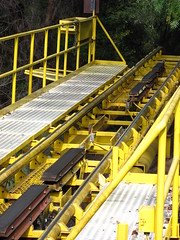

Perhaps most delightful about the Gold Rusher (at least for nerds, which if you’re reading this far I assume probably describes you) were some of the eccentric engineering touches not found on any other mine trains I’ve seen. The double tubular spine/support system eschews the traditional wooden structure and allows for a more brightly colored yellow appearance than the normal dark browns and grays. Kicker tires are present along the brakes, a feature not included on any of the other wholly gravity and chain driven Arrow Dynamic coasters, and most curious of all, the traditional pinch brakes found on all other steel coasters are absent in favor of under-friction skid brakes. Must be something different about California.
Must be something different about California.
Just a short walk down the midway one will find a towering green and black structure that belongs to Riddler’s Revenge, the 1998 B&M stand-up coaster that generally seems to rank as the de facto best stand-up coaster ever built, not that it’s all that well liked of a genre to begin with. Most people seem to dismiss stand-up coasters as an unnecessary gimmick that tends to only make rough, groin-flattening experiences of an otherwise decent layout. I’m a bit more optimistic towards these coasters than that, not only because I’m adept at riding the ‘proper’ way and haven’t found the usual worst offenders to be intolerably rough (Mantis, Iron Wolf, etc.) The stand-up position also allows for a higher center of gravity, and with the greater vertical displacement the body becomes a far more sensitive instrument to detecting forces and rotation. Since B&M aren’t exactly known for designing highly dynamic, aggressive rides, I tend to view this as a good thing at least for those who prefer more extreme sensations from their coasters.
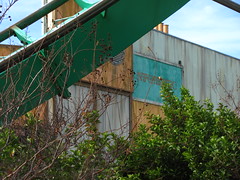 The entrance is not inside the Gotham City area like one would expect but is instead off the main midway, the ride presentation a half-breed of the old Warner Brother’s themed attention to detail like on the original Batmen, and the Premier Parks styling of gigantic flat lot coasters with cattle corral queues and shoebox stations. Once inside, the station is nicely presented as Edward Nigma’s lab with a custom theme song (who makes those for thrill rides anymore?), a techno-beat track with a layer of almost flamenco-sounding guitar that will take almost anyone back to the late 90’s regardless of if you had gone to Magic Mountain then or not. You’ll be listening to it for a lot longer if you want a row towards the front of the train, because the station is designed with the entrance in the rear where all the lines for the individual rows
The entrance is not inside the Gotham City area like one would expect but is instead off the main midway, the ride presentation a half-breed of the old Warner Brother’s themed attention to detail like on the original Batmen, and the Premier Parks styling of gigantic flat lot coasters with cattle corral queues and shoebox stations. Once inside, the station is nicely presented as Edward Nigma’s lab with a custom theme song (who makes those for thrill rides anymore?), a techno-beat track with a layer of almost flamenco-sounding guitar that will take almost anyone back to the late 90’s regardless of if you had gone to Magic Mountain then or not. You’ll be listening to it for a lot longer if you want a row towards the front of the train, because the station is designed with the entrance in the rear where all the lines for the individual rows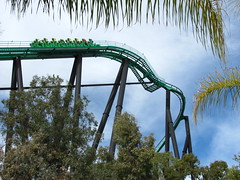 cut diagonally across to, so that the queue for the last car can barely contain four people while for the front you’ll be waiting probably about eight to ten dispatches for if full. Despite single-train operation it’s not too busy and most of the rows are close to equal, so I take the front.
cut diagonally across to, so that the queue for the last car can barely contain four people while for the front you’ll be waiting probably about eight to ten dispatches for if full. Despite single-train operation it’s not too busy and most of the rows are close to equal, so I take the front.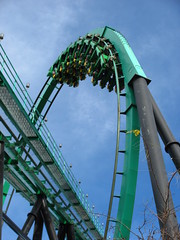
The layout is derived from 1997’s Chang, which itself was derived from 1996’s Mantis, each time getting negligibly taller and faster and with one more inversion. However, I personally think each iteration was a regression, not an improvement. The only improved aspect of the Riddler’s layout I can find is the placement of the vertical loop around the lift hill, which makes for a nice visual especially from the beginning of the lift. The first drop profile is different, substituting the elevated dipped curve and straight drop with a twisting banked plunge. This is really the less extreme approach as it maneuvers into the downgrade via a banked sideways rotation with an inward curvature (and thus constant positive G-forces) the entire way down, rather than the outward curvature and weightlessness that takes advantage of the sensitive stand-up position.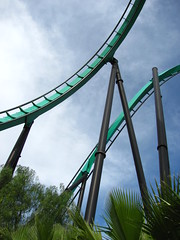
Although on the surface each ride appears to boast an ‘extra’ inversion from the last, the reality is that the layouts aren’t necessarily longer or more complicated, they just removed a non-inverting element from the previous design and inserted a loop in its place. I prefer the non-inverting elements, particularly the inclined helix over the station on Mantis and Chang over Riddler’s wholly redundant second dive loop. The helices had a greater variety of force and pacing with the S-curve entrance and variable banking on the exit, while the dive loop is a much blander maneuver with a uniform G-force,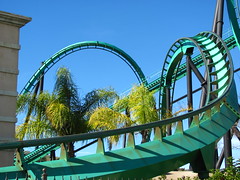 and it’s basically a copy of the element we got just a moment before. The inclined loop is still a cool treat despite the elimination of the banking wobble on the incline (why was this maneuver exclusive to the mega-stand-ups?), and there’s a quick change in pace with the banked curve before the midcourse, even though it’s missing the fast left-to-right transition with the pop of airtime in the middle. Then there’s the post midcourse brake run finale, which takes after Chang with the two corkscrews rather than Mantis with the tight figure-eight finale. Rather than demonstrate
and it’s basically a copy of the element we got just a moment before. The inclined loop is still a cool treat despite the elimination of the banking wobble on the incline (why was this maneuver exclusive to the mega-stand-ups?), and there’s a quick change in pace with the banked curve before the midcourse, even though it’s missing the fast left-to-right transition with the pop of airtime in the middle. Then there’s the post midcourse brake run finale, which takes after Chang with the two corkscrews rather than Mantis with the tight figure-eight finale. Rather than demonstrate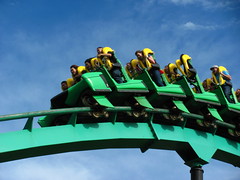 their articulated vehicle’s versatility with sharp but smooth banking transitions that constantly keep one guessing, the Revenge decides to slow the pace way down with a long, meandering second half that lazily creeps around back to the first drop, turning around and keeping one guessing only in as far as wondering when the second corkscrew will appear to liven things up. Sorry, I’m not trying to be a Debbie Downer with this comparison, I’m just calling it the way I see the respective layouts and I’m perplexed why Mantis always gets all the hate while Riddler is assumed to be the superior ride without the need for much or any justification. Is it just that Riddler’s Revenge tracks smoother than Mantis (only by a little bit for me), or is there something else I’m missing?
their articulated vehicle’s versatility with sharp but smooth banking transitions that constantly keep one guessing, the Revenge decides to slow the pace way down with a long, meandering second half that lazily creeps around back to the first drop, turning around and keeping one guessing only in as far as wondering when the second corkscrew will appear to liven things up. Sorry, I’m not trying to be a Debbie Downer with this comparison, I’m just calling it the way I see the respective layouts and I’m perplexed why Mantis always gets all the hate while Riddler is assumed to be the superior ride without the need for much or any justification. Is it just that Riddler’s Revenge tracks smoother than Mantis (only by a little bit for me), or is there something else I’m missing?
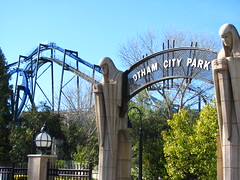
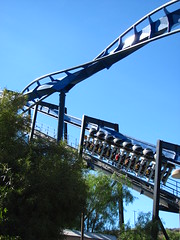 Down the block in Gotham City proper, sporting a fresh black and blue paint scheme, is Batman: The Ride. I remember the days when Batman used to be considered hot shit. Apart from some alterations to the original props and effects in the queue and station, the roller coaster today is about as good as it ever was back in 1994, but it has gotten lost amid the newer giants of the past decade.
Down the block in Gotham City proper, sporting a fresh black and blue paint scheme, is Batman: The Ride. I remember the days when Batman used to be considered hot shit. Apart from some alterations to the original props and effects in the queue and station, the roller coaster today is about as good as it ever was back in 1994, but it has gotten lost amid the newer giants of the past decade. Its demure stature at only 105’ makes it easily overlooked when surveying the thrill ride landscape of Magic Mountain, and as the third of twelve clones worldwide
Its demure stature at only 105’ makes it easily overlooked when surveying the thrill ride landscape of Magic Mountain, and as the third of twelve clones worldwide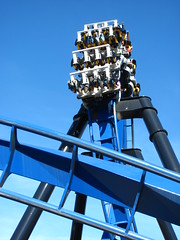 it’s understandable why this B&M invert tends to go unnoticed until one’s tour around the park brings it directly into their sightline. There should be no call for recognition, there is no need to rediscover a lost gem. I’ve been on many of the others and I knew what to expect from this one. There are no surprises. Nothing original would be learned. I would walk away from Batman wholly unchanged as a person. Obscurity suits The Ride well, like its namesake you shouldn’t be able to see it until you really need it. Lurking at the back of Gotham City Park, with two-train operation an empty queue is guaranteed for a day like today, and given the liberal attitude towards rerides the next half hour of my life would yield exceptionally pleasant, which I don’t think possible had I arrived in this moment with any prior anticipation.
it’s understandable why this B&M invert tends to go unnoticed until one’s tour around the park brings it directly into their sightline. There should be no call for recognition, there is no need to rediscover a lost gem. I’ve been on many of the others and I knew what to expect from this one. There are no surprises. Nothing original would be learned. I would walk away from Batman wholly unchanged as a person. Obscurity suits The Ride well, like its namesake you shouldn’t be able to see it until you really need it. Lurking at the back of Gotham City Park, with two-train operation an empty queue is guaranteed for a day like today, and given the liberal attitude towards rerides the next half hour of my life would yield exceptionally pleasant, which I don’t think possible had I arrived in this moment with any prior anticipation.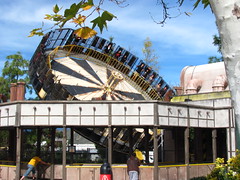
Everything I’d have to say about the merits and shortcomings of the roller coaster itself are already covered in my review of the original installation at Six Flags Great America. The good pacing is there, as is the short ride length, and the forces aren’t as strong on a day with partially loaded trains as some proponents of the make claim is possible. The desert environment isn’t as effective as Great America’s narrow calls with ponds and foliage, however the foreground mini-world of Gotham City is about as extravagant as any you’ll find at Six Flags. An entire city block is re-created, distancing itself from the midway setting that every other Batman ride is built along, and sporting a couple of complimentary (but ultimately negligible) flat rides. Immersive, sort of, 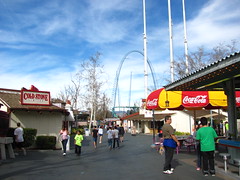 but only because a decaying metropolis is a well-suited theme for Six Flags, in which a normal trashy and stained look is only for the better.
but only because a decaying metropolis is a well-suited theme for Six Flags, in which a normal trashy and stained look is only for the better.
Which brings me to Scream!. Everything I said in praise about Magic Mountain’s shiny, Hollywood aesthetics in part one, I must retract at this point in the review. (Don’t worry; you’ll get it back in part three.) The entire back midway of the park from Cyclone Bay to Scream (excluding the Gotham City add-on, but including parts of Samurai Summit) is a depressing corridor in need of revitalization. Maybe moving in the right direction with the transformation into the DC Universe I was a bit too early to witness. The biggest strike against it is that it’s mostly flatlands and lacking in the same density of vegetation found elsewhere in the park, and that there’s an abundance of games and food shops that are never in use or completely shut down. This non-theme continues right back to 2003’s B&M Medusa clone, a ride carefully assembled to have as little disruption to the pre-existing environment as possible.
and that there’s an abundance of games and food shops that are never in use or completely shut down. This non-theme continues right back to 2003’s B&M Medusa clone, a ride carefully assembled to have as little disruption to the pre-existing environment as possible.
The faded, splotchy paint in look-at-meeee blue, magenta and yellow, the overly obvious name, the exclamation points and visually busy banners that only serve to emphasize the vicinity’s lifelessness, the awkward midway connecting point causing a stagnant cul-de-sac, the concentration camp queue leading into a square tin station, and all those lines… those fucking white parking lines everywhere. Scream is a time-portal into the early 2000’s, a glimpse back into the recent history at harsher,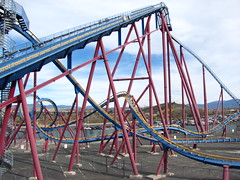 bleaker times. A time when massive capital projects were plopped down without plan or reason in an attempt to quickly inflate a stock price; a reminder to count our blessings today and to remain hopeful and optimistic towards the future. Only Six Flags under Premier Park management could install a 150’ tall seven inversion B&M floorless coaster that becomes seen as a liability against the park’s reputation; or at the very best, a benign multi-million dollar asset. I recall all those shitty teenage memories spent on Six Flags property (mostly in endless queues) near the turn of the millennium… and then I am reminded that at its core this would be a headlining attraction at nearly any other amusement park on earth, and I am granted the supreme luxury of being able to look down my nose at such a ride.
bleaker times. A time when massive capital projects were plopped down without plan or reason in an attempt to quickly inflate a stock price; a reminder to count our blessings today and to remain hopeful and optimistic towards the future. Only Six Flags under Premier Park management could install a 150’ tall seven inversion B&M floorless coaster that becomes seen as a liability against the park’s reputation; or at the very best, a benign multi-million dollar asset. I recall all those shitty teenage memories spent on Six Flags property (mostly in endless queues) near the turn of the millennium… and then I am reminded that at its core this would be a headlining attraction at nearly any other amusement park on earth, and I am granted the supreme luxury of being able to look down my nose at such a ride.
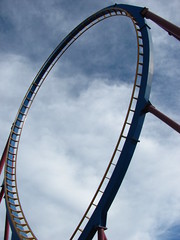 Luckily for Scream, I might be one of its harsher critics, and there are folks more willing to see past its superficial ugliness to the mathematical Swiss beauty that lay within. Among these were my riding companions, a mom-and-son team of local enthusiasts, the younger member of the duo recognizing my iSpeed t-shirt and a subsequent conversation couldn’t have been a lovelier way to pass the time waiting for a front row credit check on one train operation; particularly lovely when I found a mention of my website was met with some recognition! Even with such fine company I was still one to disagree with such an assessment, as supposing the setting in Tivoli Gardens I would nevertheless find it a rather dull, unimaginative sequence of poorly-paced inversions, the textbook example of B&M relying on formula and simply going through the motions. And it’s a bit rough. Not that I mind being beat up by coasters as there are plenty rougher within a mile radius that I would heap praise upon, but when you’ve got a track designed to neutralize as much as possible any unusual force in its aerobatics, the vibromatic seats becomes all that much more a defining feature in the overall ride experience.
Luckily for Scream, I might be one of its harsher critics, and there are folks more willing to see past its superficial ugliness to the mathematical Swiss beauty that lay within. Among these were my riding companions, a mom-and-son team of local enthusiasts, the younger member of the duo recognizing my iSpeed t-shirt and a subsequent conversation couldn’t have been a lovelier way to pass the time waiting for a front row credit check on one train operation; particularly lovely when I found a mention of my website was met with some recognition! Even with such fine company I was still one to disagree with such an assessment, as supposing the setting in Tivoli Gardens I would nevertheless find it a rather dull, unimaginative sequence of poorly-paced inversions, the textbook example of B&M relying on formula and simply going through the motions. And it’s a bit rough. Not that I mind being beat up by coasters as there are plenty rougher within a mile radius that I would heap praise upon, but when you’ve got a track designed to neutralize as much as possible any unusual force in its aerobatics, the vibromatic seats becomes all that much more a defining feature in the overall ride experience.
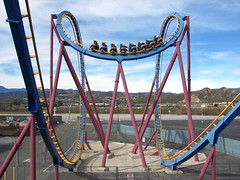 As I walked down the exit staircase, bidding goodbye to new friends while determining that a second ride would not be in the cards for me, I decided that if ever there was a candidate for Six Flags’ ride rotation program for a chance to start a new life with a different identity on a blank slate (not literally over blank slate, of course), it should be Scream. There’s the potential for something in it, maybe, but today I could only see the million dollar waste pile of material and human capital by a few people with no imagination. Leaving the Mardi Gras Monstrosity behind, I faced the theme park once again alone. The world’s largest collection of thrill rides was at my fingertips, and no one was there to tell me where to step next. So, now which way does the wind blow?
As I walked down the exit staircase, bidding goodbye to new friends while determining that a second ride would not be in the cards for me, I decided that if ever there was a candidate for Six Flags’ ride rotation program for a chance to start a new life with a different identity on a blank slate (not literally over blank slate, of course), it should be Scream. There’s the potential for something in it, maybe, but today I could only see the million dollar waste pile of material and human capital by a few people with no imagination. Leaving the Mardi Gras Monstrosity behind, I faced the theme park once again alone. The world’s largest collection of thrill rides was at my fingertips, and no one was there to tell me where to step next. So, now which way does the wind blow?
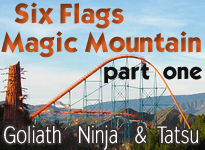
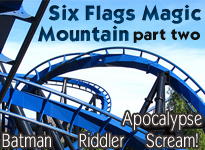
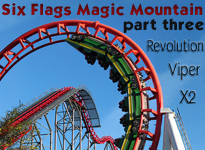
Comments